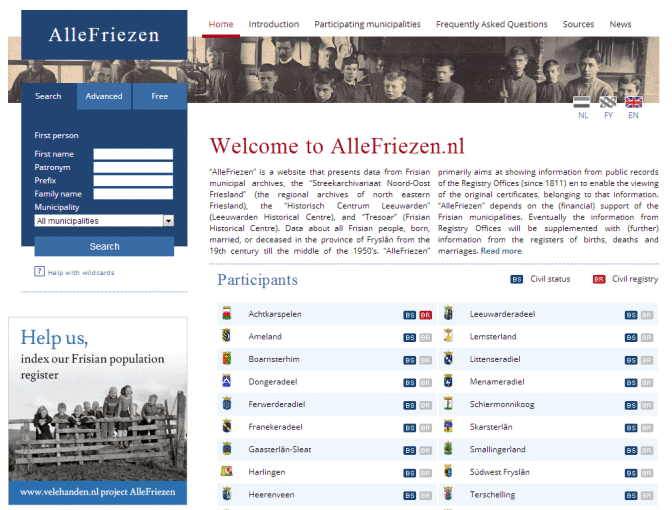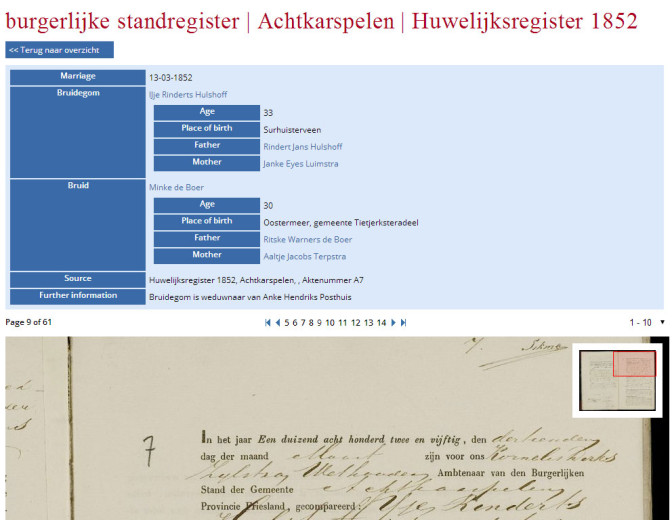If you have ancestors from Friesland, the website Alle Friezen is a must. The website contains indexes and scans of almost all the public records of the civil registration and some population registers as well.
Available information
The website contains the following information:
- Civil registration records from all municipalities in Friesland except Dantumadeel, Opsterland, Ooststellingwerf and Weststellingwerf. These last municipalities chose not to participate in AlleFriezen.
- birth records (1811-1902)
- marriage records (1811-1922)
- death records (1811-1942)
- Population registers (1850-1939) for the municipalities of Achtkarspelen, Leeuwarden and Vlieland.
Searching for information
An English version is available by clicking the British flag (EN) in the top right corner. There are three options to search for information:
- Simple, with the most used fields
- Advanced, which allows you to search for multiple people at once and restrict your search to certain sources
- Free, a full-text search. The term “free” means “free form” and has nothing to do with costs.
Simple search
The following fields are available:
- First name: first name of the person
- Patronym: the patronymic of the person. In Friesland, many people had a patronymic derived from their father’s name. See the article on patronymics for more information. When in doubt, leave blank.
- Prefix: the first part of the last name, like “De” or “Van”. See the article on prefixes for more information.
- Family name: the last name, without the prefixes.
- Municipality: a drop-down field that allows you to limit your search to one place.
Advanced search
The advanced search includes the option to fill out the details of a second person. This allows you to find records where the details of two persons match. You can use this to search for all records of a married couple, which should give you their marriage record and the birth and death records of their children.
In addition to the second person, the advanced search form also gives you the following options:
- Period: fill in the years to limit your search to records in a particular period. The filter is on the date of the record, not the livespan of the persons involved. For example, if you search for the marriage record of a person that lived from 1820 to 1880, you could limit the search to 1838 to 1860 to see if he married between the age of 18 and 40, like most people did.
- Search in: allows you to restrict your search to certain types of records.
Free search
Search for: allows you to type in the terms you are looking for and will search full-text for records that match all the terms.
Not finding what you’re looking for?
Like most Dutch genealogical websites, Alle Friezen only find records that are an exact match to your query. In other words: filling out more information decreases the number of records.
If you don’t find the record you’re looking for, try one of these strategies:
- Fill out less information
- Limit your search by period and type of source (which you can be 100% sure about) rather than names (which may be spelled differently than you think).
- Use wildcards (* for multiple characters, ? for one character) to search for variants
- Use the advanced search option to search for records that contain two people.
Another reason why you may not find what you need is that for some death records, only the names of the deceased have been indexed, so you will not find them if you search for the parents’ names. So if you miss a death record, try searching for the name of the deceased and then verify the parents’ names in the scan of the original record.
Using the results
The search results are shown in a table with one row per person. One record may be present multiple times if more than one person in that record matches your query. Just click the header of a column to sort by that field. Sorting by date is very helpful.
By clicking a row, you will get more details that should allow you to determine whether this is the person you’re looking for. Click ‘show record’ to go to the detail page for that record, which in most cases includes an image viewer that shows the scan of the original record. Press F for full screen. A ‘Download PDF’ button below the viewer allows you to download the scan for your own records.
Click “Terug naar overzicht” [back to overview] to return to the results page.
Example: IJe Rinderts Hulshoff
For this example, we are going to see what records we can find for IJe Rinderts Hulshoff, husband of Minke de Boer, who lived in Achtkarspelen in the 1850s.
Step 1: Assess the information
First, let’s take a minute to study the information and see if Alle Friezen is an appropriate website to use in this case. We go to the Sources page on Alle Friezen to get the latest information about the sources that are available. We see that Achtkarspelen is a municipality for which both civil registration records and population registers are available. IJe and Minke lived in the 1850s, a period covered by both records sets . We have definitely come to the right website and should expect to find both civil registration records and population registers.
Next, we study the information to for any peculiarities that may cause records to be missed:
- The name IJe starts with the Dutch letter -IJ-, which in Frisian is rendered as an Y. Records may use or be indexed using either spelling.
- Rinderts is a patronymic. This may or may not be included in the record or the index.
- Hulshoff ends with a double -ff. These types of duplicate letters that make no difference in pronunciation are often missed in writing or indexing. Records could well be indexed as Hulshof, so we should use the wildcard options and search for Hulshof* instead of Hulshoff to cover both variations.
- De Boer has a prefix, “de.” We should be careful to put that in the appropriate search field, and not search for de Boer as the surname.
Step 2: Fill out the search form
Since the spelling of IJe’s first name is uncertain, we’re going to start our search by just looking for all records of a Hulshoff marrying a De Boer.
- Click advanced to go to the Advanced search form
- Fill out the form:
- First person – family name: Hulshof*
- Second person – prefix: de
- Second person – family name: Boer
- Click Search
We get 83 results, which is doable but could be more manageable by further limiting our search. We add the first name Minke* to the second person in the Advanced Search form and search again. The wildcard is added in case she has more than one first name. We now get just six results, which represent three records:
- Their marriage record, indexed once for groom IJe Hulshoff and once for his father Rindert Hulshoff
- A birth record, indexed once for the name of the father (IJe Hulshoff) and once for the child (Aaltje Hulshoff)
- A marriage record, indexed once for the name of the bride (Aaltje Hulshoff) and once for the name of the father (IJe Hulshoff)
Step 3: View records
If we click on the marriage record, it will show more details and an option to view the zoomable image or download the PDF document.
Cost of using the website
This is a free website. There are no charges for using the website or downloading high-resolution scans.




Yvette,
I want to let you know that your blog is listed in my Fab Finds post at http://janasgenealogyandfamilyhistory.blogspot.com/2014/01/follow-friday-fab-finds-for-january-31.html
Have a great weekend!
Fabulous! Thank you so much! Have a great weekend too 🙂
I am smiling because your example uses my ancestors! I am wondering if they were a random choice, or if not, what made you choose them? 😀
I’m married to IJe Rinderts’ g-g-g-grandson 🙂 Hiya cousin!
Ah! Cousin! Let’s share information!